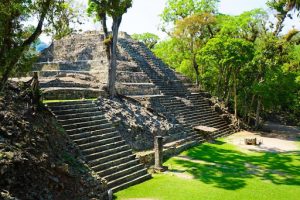 In 1839, two American explorers heard stories of mysterious ruins in the rain forests of Central America. Curious, they set out to see for themselves. The two men first explored the remains of the city of Copán (/koh*pahn/) in the present-day country of Honduras. From the architecture, it was clear the ruins had been left by an ancient and advanced civilization. The two Americans continued their journey, exploring many other ruins. Then, they returned to the United States and wrote a best-selling book about their findings. Their tales and drawings inspired worldwide interest in the history of the Maya.
In 1839, two American explorers heard stories of mysterious ruins in the rain forests of Central America. Curious, they set out to see for themselves. The two men first explored the remains of the city of Copán (/koh*pahn/) in the present-day country of Honduras. From the architecture, it was clear the ruins had been left by an ancient and advanced civilization. The two Americans continued their journey, exploring many other ruins. Then, they returned to the United States and wrote a best-selling book about their findings. Their tales and drawings inspired worldwide interest in the history of the Maya.
Since the mid-1800s, archaeologists and other experts have continued to study these remarkable people. Recent breakthroughs in research have revealed just how much the Maya accomplished. Let’s take a closer look at what we know about them and what still remains a mystery.
At its peak, the Maya civilization included a large group of city-states that were allied with, fought, and conquered each other. These cities were located on the Yucatán Peninsula in what is today southeastern Mexico and the countries of Guatemala, Honduras, and Belize. Archaeologists believe that Maya civilization reached its greatest extent between about 200 and 900 CE.
The largest buildings in Maya cities were pyramids that also served as temples.
These structures served religious purposes. From their size, it is clear that religion was a key part of Maya life. Maya pyramids rose high above the surrounding treetops. Maya pyramids were some of the tallest structures in the Americas until 1902. That year, the twenty-two-story Flatiron Building was constructed in New York City.